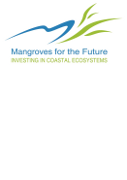Grants :: Small Grant Facilities :: Community Capacity Building for Coastal and Mangrove Conservation of Tambon Khlong Pasong
Community Capacity Building for Coastal and Mangrove Conservation of Tambon Khlong Pasong

Activity on mangrove conservation. © GEF SGP Thailand/ Suwimol Serepaowong, 2012.
Objectives
1) To build capacity of community on coastal resources management
2) To demonstrate management activities through participatory process
3) To instill awareness on conservation and sustainable use of coastal resources and mangrove
Background
Environmental Conservation Group of Koh Klang Village: Registered as a CBO on 28 September 2001, as a recommendation from the Bank of Agriculture and Agricultural Cooperatives in Krabi Province, aiming to reduce conflict amongst community members who had regularly struggled and fought to provide services for tourists. With subsequent financial supports from several national and international organizations, the group has experienced in community waste management, documentation of wetland conservation and mangrove protection manual.
Target beneficiaries
All 100 households who earn their living through fishery and depend upon provisions of mangrove for livelihood activities. The per capita income is THB 48,000.
Outputs
Expected Outputs
|
Main Activities (กิจกรรม) |
Main Anticipated Result (ผลที่คาดว่าจะได้รับ) |
|
1. Building capacity of communities through meetings, training, workshop and study tours stressing on sustainable use of coastal resources and mangrove 2. Launching reforestation to rehabilitate degraded mangrove, and to slow down soil erosion as well as producing organic fertilizer to address land-based pollution 3. Launching dissemination of the project |
1. The 3 capacity-building activities resulting in increased awareness and capacity of targeted population in mangrove management and community food security witnessed by active sharing and discussion to proceed with additional plans and putting into practice what had been learnt 2. A certain amount of community and fishery waste being turned into organic fertilizer 3. Additional 3.000 mangrove being grown for a distance of 2 km to prevent sea water intrusion 4. Additional contribution from Krabi Provincial Administrative Organization for building bamboo wall to slow down shore erosion 5. A deserted shrimp farm of about one ha being recovered with 1,000 seedlings of a mangrove species (Cork Tree or locally so-called Lamphoo) 6. A document containing 20 mangrove species 7. Increased capacity of targeted population witnessed through co-management of the ecosystems with relevant authorities - fairly outstanding – generating additional income by eco-tourism engagement and reducing pressures on the ecosystems 8. The project being incorporated in a national income generation scheme of the Provincial Chamber of Commerce and the Bank for Agriculture and Agricultural Cooperative |
Accomplishments and challenges
1) The project referred to community participation, dealing with direct community problems and supports from government agencies/local administrative organization as main factors for accomplishment. Transparency was the thing that should be a mantra (every project member should have a clear answer).
2) Lack of clear know-how on planting Lamphoo and Pipi seedlings
Contributions to cross-cutting themes
Gender equality
The elder and women group participating in activities on mangrove reforestation, capacity building and knowledge and experience sharing with young people made a more harmonized picture in social interaction.
Lessons Learned
1) Women, elderly persons, and youth were able to play a leading role in implementing the project, as they seemed to have more free time. These 3 groups should be encouraged to participate in any community activities, to ensure smooth and effective implementation.
2) In reforestation of mangrove, careful consideration should be given to selection of suitable species if high rate of survival was to be achieved.
3) Growing cork tree through nurseries process, i.e. putting them into plastic bags, was not recommended, as the rate of survival was very low.
4) Reforestation of deserted shrimp farms provided both direct and indirect benefits to the group. Directly, mangrove area was increased where community member would use for black crabs raising to generate additional income. Indirectly, the activities demonstrated possibility of reclaiming degraded mangrove area, thus encourage replication. As the matter of fact, the rehabilitated shrimp farms of the groups had become learning places for both targeted communities and external communities.
Project Facts
Country
Location
Tambon Khlong Prasong with an area of about 26 sq.km, included in Krabi Estuary , a wetland of international importance (Ramsar Site), Muang District, Krabi Province.
Topic
- Community Resilence
- Strategies for Management
- Sustainable Business Practices
- Sustainable Livelihoods
Duration
19th Jun 2012 to 31st Aug 2013
MFF Grant Amount
302,000 THB
Co-financing Partner
|
From (งบจาก) |
In cash (เงินสด) |
In kind (แรงงาน สิ่งของเครื่องใช้ ที่ดิน ฯลฯ) |
|
Mangrove Development Station 26 |
- |
120,000 |
|
Students from schools in Krabi provincial town |
- |
15,000 |
|
Krabi Bicycle Group |
- |
30,000 |
|
Total (THB) |
- |
165,000 |
Implementing Partner
Mr. Nont Meelam, Project Leader, 118, Moo 1, Tambon Khlong Pasong, Muang District, Krabi Province, 81000.
Related Publications

Community Capacity Building for Coastal and Mangrove Conservation of Tambon Khlong Pasong
Author: MFF Thailand
Posted on: 4th Dec 2013
Category:
Size: 708 KB